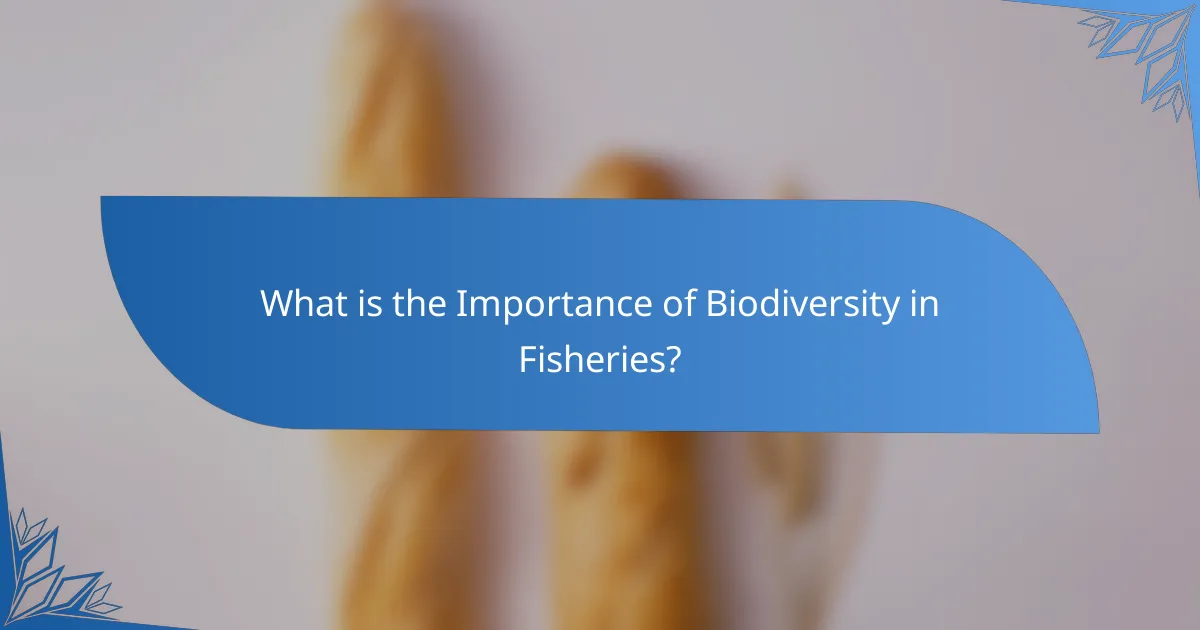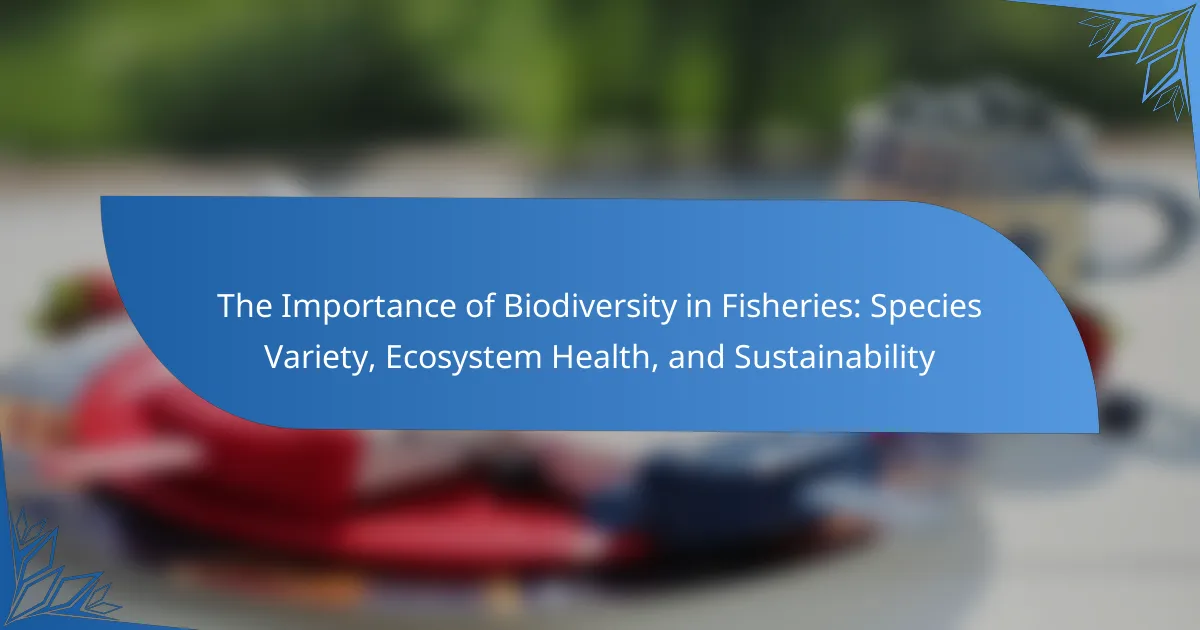
What is the Importance of Biodiversity in Fisheries?
Biodiversity in fisheries is crucial for maintaining ecosystem health and sustainability. It ensures a variety of species, which contributes to resilience against environmental changes. Diverse fish populations can adapt better to diseases and climate fluctuations. A rich biodiversity supports complex food webs, promoting stability in marine ecosystems. Additionally, it enhances productivity and resource availability. According to the Food and Agriculture Organization, diverse fisheries yield higher catches. This diversity also supports livelihoods for millions of people globally. Thus, biodiversity is essential for both ecological balance and economic stability in fisheries.
Why is species variety crucial for fisheries?
Species variety is crucial for fisheries because it enhances ecosystem resilience and productivity. Diverse species contribute to a balanced food web, supporting various trophic levels. This balance helps maintain fish populations and their habitats. A study by the Food and Agriculture Organization (FAO) shows that diverse fisheries are more productive and stable over time. Additionally, species variety allows for better adaptation to environmental changes. It reduces the risk of collapse due to overfishing or disease. Overall, maintaining species variety is essential for sustainable fisheries management and long-term ecological health.
What are the key species that contribute to biodiversity in fisheries?
Key species that contribute to biodiversity in fisheries include finfish, crustaceans, mollusks, and various aquatic plants. Finfish, such as tuna and salmon, are vital for ecosystem balance. Crustaceans like shrimp and crabs play important roles in nutrient cycling. Mollusks, including clams and oysters, contribute to water filtration and habitat structure. Aquatic plants, such as seagrasses, provide essential habitats and food sources. These species support food webs and enhance resilience against environmental changes. Their presence is crucial for maintaining healthy and sustainable fisheries.
How does species variety impact fish populations?
Species variety significantly impacts fish populations by enhancing ecosystem resilience and stability. Diverse species fulfill different ecological roles, which helps maintain balanced food webs. This balance supports higher productivity and sustainability in fish populations. For example, a study by Worm et al. (2006) in “Science” found that diverse marine ecosystems are more productive than monocultures. Additionally, species variety can reduce competition for resources, allowing for greater growth and reproduction rates among fish. This diversity also provides a buffer against environmental changes, such as climate shifts or pollution. Therefore, maintaining species variety is crucial for the health and sustainability of fish populations.
How does biodiversity influence ecosystem health in fisheries?
Biodiversity significantly influences ecosystem health in fisheries. It enhances resilience against environmental changes and disturbances. Diverse species contribute to various ecological roles, promoting stability. For instance, different fish species can occupy unique niches, reducing competition for resources. This leads to balanced food webs, which support overall ecosystem productivity. Studies show that ecosystems with higher biodiversity are more productive and sustainable. Research by Worm et al. (2006) in “Nature” indicates that biodiversity boosts fishery yields and ecosystem services. Thus, maintaining biodiversity is crucial for healthy fisheries.
What role do diverse species play in maintaining ecosystem balance?
Diverse species play a crucial role in maintaining ecosystem balance. They contribute to various ecological functions and processes. For example, species diversity enhances productivity and stability in ecosystems. A variety of species can utilize different resources, reducing competition and promoting coexistence. This leads to more resilient ecosystems that can better withstand disturbances. Research shows that ecosystems with higher biodiversity are more productive and efficient. In fisheries, diverse species help regulate populations and maintain food web dynamics. A balanced ecosystem supports sustainable fish stocks and overall health.
How does the loss of biodiversity affect ecosystem services?
The loss of biodiversity negatively impacts ecosystem services. Ecosystem services include provisioning, regulating, supporting, and cultural services. A decline in species variety reduces the availability of food, clean water, and raw materials. This loss disrupts ecological balance and diminishes natural pest control. Pollination services also decline, affecting food production. The degradation of habitats leads to increased vulnerability to climate change. Studies show that diverse ecosystems are more resilient and can recover from disturbances more effectively. Biodiversity loss ultimately threatens human well-being and sustainability.
What are the sustainability implications of biodiversity in fisheries?
Biodiversity in fisheries is crucial for sustainability. It enhances ecosystem resilience and productivity. Diverse species contribute to balanced food webs. This balance supports fish populations and their habitats. Healthy ecosystems are better at recovering from environmental changes. Biodiversity also provides genetic variety, which is essential for adaptation. Studies show that fisheries with higher biodiversity yield more sustainable catches. For example, a report by the Food and Agriculture Organization states that diverse fisheries are more resilient to overfishing. Thus, preserving biodiversity is vital for long-term sustainability in fisheries.
How does biodiversity contribute to the resilience of fisheries?
Biodiversity enhances the resilience of fisheries by providing a variety of species that can adapt to changing environmental conditions. This diversity allows ecosystems to maintain functionality even when faced with stressors such as climate change or overfishing. A diverse fish population can ensure that some species thrive under adverse conditions, supporting overall fishery productivity. Moreover, different species fulfill various ecological roles, contributing to nutrient cycling and habitat stability. Studies indicate that ecosystems with higher biodiversity are better able to recover from disturbances. For example, a research study published in “Ecological Applications” by Worm et al. (2006) found that diverse marine ecosystems showed greater resilience to fishing pressures. Thus, biodiversity is crucial for sustaining healthy fisheries and ensuring long-term ecological balance.
What practices promote sustainable fishing and biodiversity?
Sustainable fishing practices include catch limits, habitat protection, and bycatch reduction. Catch limits prevent overfishing by setting a maximum amount of fish that can be harvested. Habitat protection preserves critical ecosystems like coral reefs and mangroves, which support diverse marine life. Bycatch reduction techniques minimize the unintended capture of non-target species, reducing ecological impact.
Research shows that implementing these practices can lead to healthier fish populations and improved biodiversity. A study by the Food and Agriculture Organization (FAO) highlights that fisheries employing sustainable practices can recover fish stocks and enhance ecosystem resilience. This evidence supports the effectiveness of sustainable fishing methods in promoting biodiversity.
What connections exist between biodiversity and fishery management?
Biodiversity and fishery management are interconnected as biodiversity supports the sustainability and health of fish populations. Healthy ecosystems with diverse species contribute to resilience against environmental changes. Diverse fish populations are crucial for maintaining ecological balance and ensuring productive fisheries. Effective fishery management practices often involve protecting habitats that support a variety of species. Research shows that ecosystems with higher biodiversity tend to have greater productivity and stability. For example, studies indicate that diverse fish communities can better withstand overfishing pressures. Thus, managing fisheries with an emphasis on biodiversity leads to more sustainable outcomes for both fish populations and the ecosystems they inhabit.
How can we assess the current state of biodiversity in fisheries?
Assessing the current state of biodiversity in fisheries involves several key methods. These include species inventory assessments, ecological surveys, and genetic studies. Species inventory assessments catalog the variety of fish species present in a specific area. Ecological surveys evaluate the habitats and interactions within the ecosystem. Genetic studies analyze the genetic diversity among fish populations.
Data collected from these methods provide insights into population sizes, distribution, and health. For instance, the International Union for Conservation of Nature (IUCN) Red List provides a global assessment of species’ conservation status. This assessment helps identify species at risk and informs conservation efforts. Monitoring changes over time is crucial for understanding trends in biodiversity.
Regular assessments can indicate the impacts of overfishing, habitat destruction, and climate change on fish biodiversity. Using these methods collectively enhances our understanding of fisheries’ ecological health and sustainability.
What are effective strategies for enhancing biodiversity in fisheries?
Effective strategies for enhancing biodiversity in fisheries include habitat restoration, sustainable fishing practices, and the establishment of marine protected areas. Habitat restoration improves the living conditions for various species. This can involve replanting aquatic vegetation and restoring coral reefs. Sustainable fishing practices reduce overfishing and bycatch. Techniques such as catch limits and selective gear minimize ecological impact. Marine protected areas safeguard critical habitats from destructive activities. Research shows that these areas can increase species richness and abundance. A study by Sala et al. (2018) indicates that marine reserves can lead to a 20-30% increase in fish populations. Implementing these strategies can significantly enhance biodiversity in fisheries.
Which conservation methods are most successful in fisheries?
Successful conservation methods in fisheries include marine protected areas (MPAs), sustainable fishing practices, and habitat restoration. MPAs help to protect critical habitats and allow fish populations to recover. Studies show that MPAs can lead to increased fish biomass by up to 600% over time. Sustainable fishing practices, such as catch limits and gear restrictions, help to prevent overfishing and preserve fish stocks. Research indicates that fisheries employing sustainable practices have a 30% higher yield than those that do not. Habitat restoration, including coral reef rehabilitation and mangrove restoration, is essential for enhancing biodiversity and ecosystem health. These methods collectively contribute to the long-term sustainability of fisheries and the overall marine ecosystem.
How can stakeholders collaborate to improve biodiversity outcomes?
Stakeholders can collaborate to improve biodiversity outcomes by engaging in joint conservation efforts. Collaborative initiatives can include habitat restoration projects, which enhance ecosystems. Sharing resources and knowledge among stakeholders promotes effective management strategies. Regular communication fosters trust and alignment of goals. Stakeholders can also participate in policy advocacy to influence regulations positively. Research partnerships can lead to innovative solutions for biodiversity challenges. Monitoring and evaluation of biodiversity initiatives ensure accountability and success. Collaborative frameworks have been shown to increase biodiversity, as evidenced by successful case studies in marine conservation.
What best practices can be implemented to support biodiversity in fisheries?
Implementing best practices to support biodiversity in fisheries involves several key strategies. Establishing marine protected areas can help preserve critical habitats. These areas allow ecosystems to recover and thrive without human interference. Utilizing sustainable fishing practices reduces overfishing and bycatch. For instance, adopting catch limits based on scientific assessments ensures fish populations remain healthy. Promoting the use of selective fishing gear minimizes the impact on non-target species. Implementing habitat restoration projects can enhance degraded environments. These projects often involve replanting vegetation and rebuilding coral reefs. Engaging local communities in conservation efforts fosters stewardship and awareness. Education and outreach initiatives can encourage sustainable practices among fishers. Collectively, these practices contribute to the resilience of marine ecosystems and the sustainability of fisheries.
The main entity of the article is biodiversity in fisheries, which plays a crucial role in maintaining ecosystem health, resilience, and sustainability. The article outlines the importance of species variety in enhancing productivity and stability within marine ecosystems, emphasizing how diverse fish populations can better adapt to environmental changes. Key species contributing to biodiversity, such as finfish, crustaceans, and aquatic plants, are highlighted for their roles in supporting food webs and ecosystem functions. Additionally, the article discusses the implications of biodiversity loss on ecosystem services, effective strategies for enhancing biodiversity, and the interconnectedness of biodiversity with fishery management practices. Overall, the article underscores the necessity of preserving biodiversity for the long-term sustainability of fisheries and the well-being of human populations reliant on these resources.



